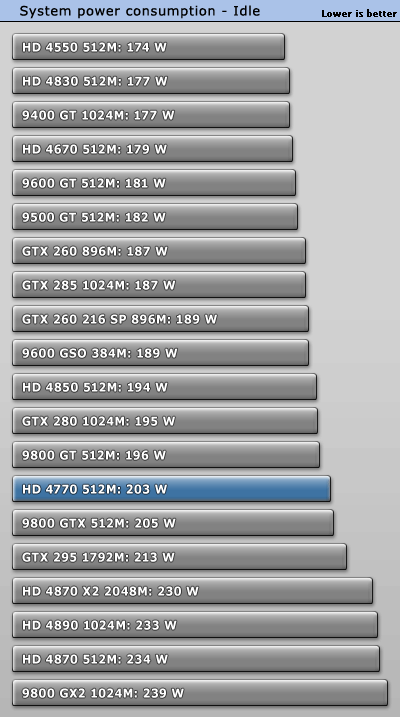 51
51
AMD Radeon HD 4770 Review
Fan Noise »Power Consumption
Cooling modern video cards is becoming more and more difficult, especially when users are asking for quiet cooling solutions. That's why the engineers are now paying much more attention to power consumption of new video card designs.| Test System | |
|---|---|
| CPU: | Intel Core i7 920 @ 3.8 GHz (Bloomfield, 8192 KB Cache) |
| Motherboard: | Gigabyte X58 Extreme Intel X58 Kindly supplied by Gigabyte |
| Memory: | 2x 1024MB OCZ DDR3 Platinum @ 1140 MHz 6-6-6-19 |
| Harddisk: | WD Raptor 740ADFD 74 GB |
| Power Supply: | BFG ES-800 800W |
| Software: | Windows Vista SP1 |
In order to characterize a video card's power consumption, the whole system's mains power draw was measured. This means that these numbers include CPU, Memory, HDD, Video card and PSU inefficiency.
The three result values are as following:
- Idle: Windows sitting at the desktop (1024x768 32-bit) all windows closed, drivers installed.
- Average: 3DMark03 Nature at 1280x1024, 6xAA, 16xAF. This results in the highest power consumption. Average of all readings (two per second) while the test was rendering (no title screen).
- Peak: 3DMark03 Nature at 1280x1024, 6xAA, 16xAF. This results in the highest power consumption. Highest single reading
In idle the power consumption is not very impressive, I had much higher (in that case lower) hopes for a midrange 40 nm GPU board.
Under load the picture changes dramatically. The HD 4770 is one of the most efficient designs when it comes to performance per Watt. It is only topped by the HD 4830 and the HD 4670. NVIDIA's 9800 GT is trailing behind, far out of sight, with over 20% less performance/Watt.



Jul 13th, 2025 03:04 CDT
change timezone
Latest GPU Drivers
New Forum Posts
- USB Hub - DeskMini (8)
- Best motherboards for XP gaming (117)
- 9800x3D - 6400 CL32 1:1 not stable (13)
- Archival HDD constantly starting up for no reason (0)
- 6400c30 vs 8000c36 Ryzen 9800X3D (1)
- 9070XT BIOS flash (what to use?) (6)
- New ToS of Take Two and 2K (12)
- Radeon RX 6700, 6700 XT & 6750 XT users club (1138)
- Is there a WIFI chip I should get? (1)
- What are you playing? (23945)
Popular Reviews
- Fractal Design Epoch RGB TG Review
- Lexar NM1090 Pro 4 TB Review
- Corsair FRAME 5000D RS Review
- Our Visit to the Hunter Super Computer
- NVIDIA GeForce RTX 5050 8 GB Review
- NZXT N9 X870E Review
- Sapphire Radeon RX 9060 XT Pulse OC 16 GB Review - An Excellent Choice
- AMD Ryzen 7 9800X3D Review - The Best Gaming Processor
- Upcoming Hardware Launches 2025 (Updated May 2025)
- Chieftec Iceberg 360 Review
TPU on YouTube
Controversial News Posts
- Intel's Core Ultra 7 265K and 265KF CPUs Dip Below $250 (288)
- Some Intel Nova Lake CPUs Rumored to Challenge AMD's 3D V-Cache in Desktop Gaming (140)
- AMD Radeon RX 9070 XT Gains 9% Performance at 1440p with Latest Driver, Beats RTX 5070 Ti (131)
- NVIDIA Launches GeForce RTX 5050 for Desktops and Laptops, Starts at $249 (120)
- NVIDIA GeForce RTX 5080 SUPER Could Feature 24 GB Memory, Increased Power Limits (115)
- Microsoft Partners with AMD for Next-gen Xbox Hardware (105)
- Intel "Nova Lake‑S" Series: Seven SKUs, Up to 52 Cores and 150 W TDP (100)
- NVIDIA DLSS Transformer Cuts VRAM Usage by 20% (97)